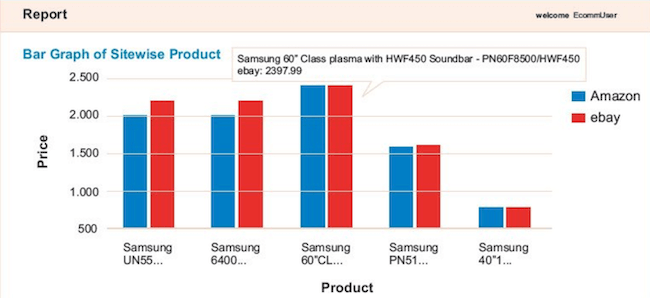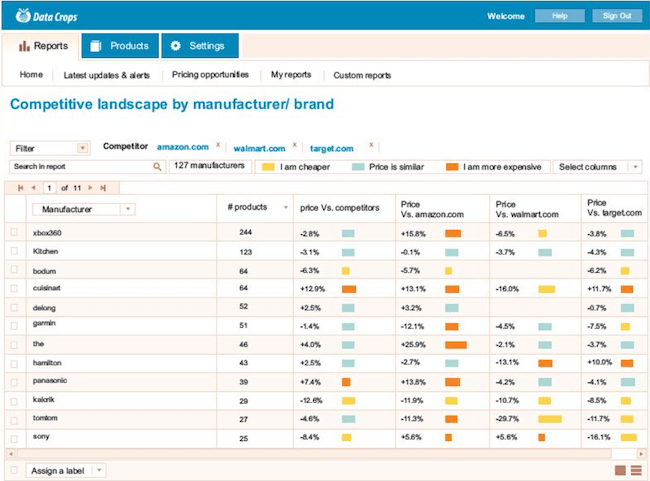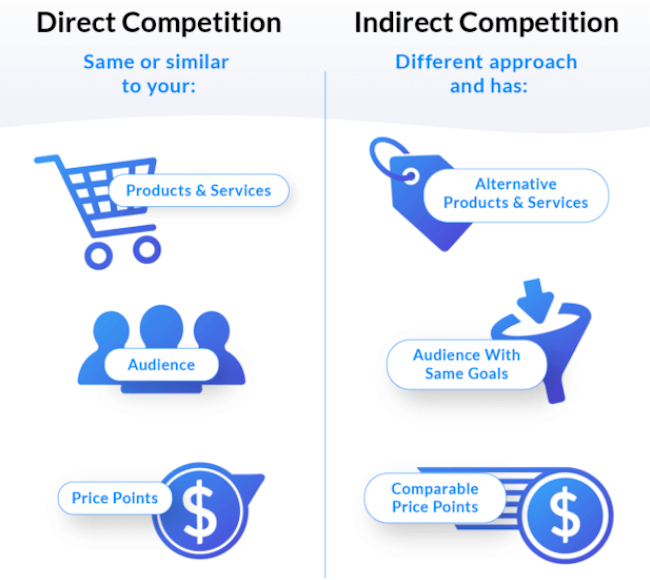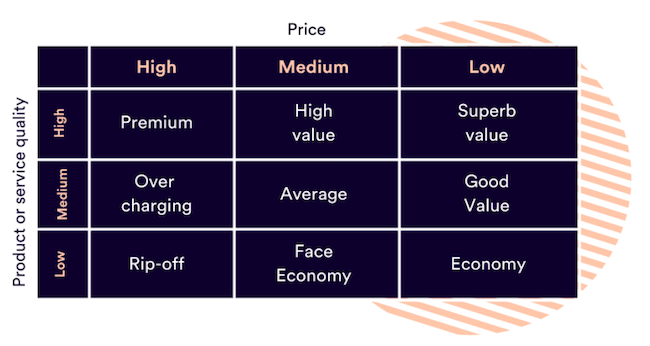Working out how to price a product can be a challenge for any business. There’s a lot that can determine what the right price should be for your product or service to ensure you get a competitive edge on the competition, while still achieving the profit margin you want.
Price too high and you’ll scare away potential customers. Opt for a lower price and you could seriously damage your turnover and profits.
But one common pricing policy used by businesses across all sectors is to use competitive pricing.
Pricing your products based on the competition is not only a great starting point, it can also help distinguish your brand while protecting your market share.
This is particularly important for retail businesses: as they’re not necessarily competing on products — because they’re all selling the same types of products — they need another differentiator to attract customers.
However, competitive pricing requires a lot of analysis and research to do effectively.
In this guide, we take a look at the topic of competitive pricing analysis and show you how you can use it to beat out the competition.
Free eBook: Gain a competitive advantage by levelling up your market research
What is a competitive pricing analysis?
Competitive pricing analysis involves completing an in-depth study of your market and how your competitors price their products in comparison to you.
While it’s used across industries and business sizes, competitive pricing is particularly popular in markets with high sales volumes, typically due to the same types of products being sold.


Industries like retail, for example, regularly use competitive pricing, especially online as prices can fluctuate regularly.
Competitive pricing analysis should arguably form part of every pricing strategy, as how you price yourself against the market can have a huge impact on your marketing strategy, how you’re viewed in the market, and – ultimately – how successful your sales will be.
Benefits of a competitive pricing analysis
As we’ve mentioned, competitive pricing analysis should form part of every pricing policy, regardless of whether it’s the main metric you plan to use.
Now, there are several benefits to using competitive pricing analysis, all of which help to guide your decision making and ensure you place and price your product in a way that appeals to customers.
Here’s just a few:
1) Avoid lost profits
However you want to position yourself in the marketplace, it’s impossible to do this properly unless you know what the competition is doing.
You can’t position yourself as a more expensive, but better quality product or service, without a barometer of where your price sits against the competition. But a bigger risk is severely underpricing your product and potentially losing profits.
2) Grow your market share
Understanding your pricing, and where it puts you against the competition, is essential when it comes to increasing market share and getting one over the competition.
Competitive pricing analysis across your entire product or service range can also help you identify areas of opportunity, e.g. where you could potentially lower prices of some products to grow your market share.
This is particularly popular with retailers.
Sometimes referred to as a ‘loss leader’ a company might look to increase their overall market share by reducing the costs of low-value items to increase overall sales.
3) Track your market position
Your prices should never be static. As the market changes, so should your prices.
A simple way to get a better understanding of where to set your prices is to use your competitors’ pricing over time.
Keeping pace with your competitors means you maintain your price position in comparison to them. Alternatively, if your competitors change their prices, you can use this as an opportunity to get a strategic price advantage over them in the short term.
But the only way to do this is to carry out an analysis of your competitors’ pricing regularly.
4) Exploit your competitors’ pricing
If you understand your competitors’ pricing and where it sits in the market as a whole, you could use weaknesses in their marketing strategy to test your own prices and find a sweet spot that you can take advantage of.
For example, if you and your competitors sell very similar products and services but yours are jam-packed with business-critical features, one approach is to change your product messaging and pricing to be reflective of how much better your product is.
A side-by-side comparison on a pricing page, for instance, can quickly highlight the advantages of your products and services, justifying a price increase. On the other hand, if you can utilise economies of scale to produce products and services for less, you can potentially undercut competitors and sell at a higher volume.
5) Improve your own pricing position
By carrying out a competitive pricing analysis you reduce the chances of losing customers to competitors by ensuring your pricing continues to remain competitive in comparison to the market and in line with your revenue and profit goals.
For example, luxury brands maintain higher pricing to attract wealthier customers. Typically, these brands have a long-standing reputation, e.g. Rolex. However, if they fail to recognise a competitors’ price increase (and find out why), they could find themselves being deemed as the “cheap alternative”.
What are the challenges with using competitive pricing analysis?
While competitive pricing analysis can be a great weapon in your marketing and sales arsenal, it doesn’t come without its challenges.
There’s a lot of research and interpretation of companies, cost, and industry breakdown to understand how your competitors are pricing their products. And understanding all of this is key to taking advantage.
Here are some of the key challenges you could face when doing a competitive analysis.
Errors in pricing analysis
Analysing competitors’ prices can be prone to errors if you use the wrong price checking tools or try to carry out the process manually.
Carrying out a market-wide price comparison of your competitors can be intensive and laborious, and you have to take into account that prices can change quickly.
In many industries, particularly retail, the selling price of products can change daily, in line with promotions and offers. As a result, if you’re comparing prices infrequently, you can easily find yourself with incorrect matches.
Finding like-for-like products
To be effective, your price comparison must be focused on like-for-like products or services.
If there are other factors to take into consideration — like features or overall value proposition — your price matching won’t offer any benefit unless it also takes into account these additional tangible benefits and features.
Understanding in-store and e-commerce pricing
With businesses moving more of their operations online, your price analysis needs to take into account price fluctuations not just between you and your direct competitor, but how your competitor’s pricing strategy differs between their physical store and online.
The problem here is that competitive pricing data can still be a highly manual process, which is inefficient when price changes can happen daily, and many businesses offer online-only offers.
Your competitor pricing analysis, therefore, must take into account every sales channel your competition is using.
Taking a short-term approach to pricing strategy
Your pricing strategy should always take a long-term approach to your pricing, but too often pricing strategies are replaced with short-term tactical decisions that can damage your market share.
Rather than taking a complete view of the competitive landscape – competitor pricing across their entire portfolio for example – pricing information is often used to change prices of individual products, regardless of the marketplace.
What this can result in are pricing actions that reduce the competitiveness of your product value as a whole.
How to conduct a competitive pricing analysis
Analysing the competition can give you a head start winning over your target audience, but there’s a lot of research that goes into a pricing strategy, and some of the information you gather might make you look differently at the market.
Here are the key things to look at when analysing a competitor’s pricing strategies:
Find your direct and indirect competitors
This stage involves taking on the role of your customer and searching your direct competitors to understand how they price products that are in direct competition with you.
But you also need to consider your indirect competitors too and how much weight you should put into their pricing when developing your own strategy.
For example specialist stores, online marketplaces, or local traders who could eat into your profits.
Remember direct competitors are those who operate specifically in your market, indirect competitors might not operate directly in your market, but their products and services can compete with you.

Research their value proposition
Your competitive analysis should examine the entire value proposition of your competitor’s products so you can understand whether or not you’re actually competing on price alone.
Look at your competitor’s marketing strategies, look at their sales brochures.
Are they competing with you on price for the same product? Or is there something else in the value proposition that impacts how they price products and services?
You need to know this before setting your own price otherwise you won’t be setting prices based on a level playing field.
Analyse and compare prices
Once you’ve filtered out products and services with different value propositions, now you should look at the price your competitors set for their products.
Don’t just look at their prices now, you should use historical data to fully understand their overall pricing strategy.
For example, do they often lower prices of particular products at particular times? If so, why?
Do they alter prices in line with seasonal changes and how do they deal with offers and promotions that could impact your own pricing if you’re trying to stay competitive.
All this information can help you establish a long-term pricing strategy that ensures you stay competitive at all times and retain or grow your market share.
Price your products perfectly with our Pricing Survey template
Implementing a competitive pricing strategy
Once you’ve completed your pricing analysis, you can now implement a competitive pricing strategy that positions you in the market against your competitors.
You’ll have three options:

Price above the market
Depending on your market share and the perception of your brand, you could price yourself as a premium product and go above the market price of your competitor.
This carries the obvious risk that you could lose potential customers looking simply for a lower price (and you’ll have to monitor competitor prices closely in case they reduce costs further)
Price match
If you want to compete on price alone, you can set your own prices in line with your competitors.
This could be beneficial if you have a large market share or can beat the competition on value as your potential customers could see your value proposition as a bonus.
Deciding to set prices in line with the market can mean keeping up with fluctuations in price within the market to avoid falling behind and reducing your profit.
Price below the market
If you want your price to be a differentiator and a means of attracting potential customers, you could position yourself as a cheaper option when it comes to cost.
Competing on cost does carry some risks, particularly if your customers see you simply as a cheap alternative.
However, you can strategically price some products as a loss leader to entice customers in and make up the profit on the rest of your portfolio of products or services.
Other pricing strategies
Of course, competitive pricing is just one pricing strategy you can use, and it’s not always good to use one strategy in isolation.
Whether you also want to factor in market conditions, your own variable costs for producing products and services, or seasonal changes, there’s a lot to think about for your pricing strategy.
You can read our blog on 12 Proven Pricing Strategies and Models for more information.
How Qualtrics can help you find the perfect price point
Correctly pricing your products can be the difference between success and failure, and when pricing depends so heavily on research, you need to invest in the right tool.
At Qualtrics, our data-driven pricing analysis software can put you ahead of the market based on your preferred pricing strategy.
We can run a range of pricing analyses like conjoint analysis to measure the value customers place on particular features of a product or service, including the price. These pricing analyses will also help you identify the optimal bundle of product benefits to help you beat out the competition.
With Qualtrics software, you can put all your product features and measure price sensitivity all under one umbrella, allowing you to compare price ranges from multiple studies so you can confidently launch your product at the optimal price.
Want to know more about pricing products for maximum profitability? We cover the topic in more detail in our How to Price Products for Maximum Profitability eBook.
Price your products for maximum profitability with our eBook